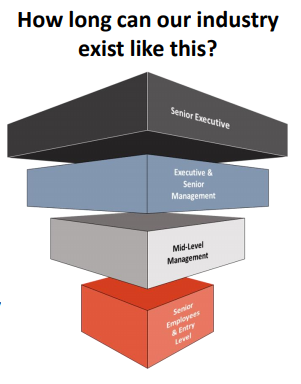Steel Products

Millennials on Millennials: We Want to Make a Difference
Written by Sandy Williams
September 9, 2017
Millennials are the steel industry’s future and are anxious to solve problems and get results. Attendees who remained for the final presentation at the SMU Steel Summit heard an eye-opening discussion on just what the millennial generation is seeking and how the steel industry can recruit and retain talent from this important demographic.
Three young professionals from Pacesetter, Cargill, and Hubbell, Inc., offered their insights on millennial behavior, goals, and recruitment.

They want employers to take an interest in their work and offer direction. And they want recognition for their efforts. “If you want me to do something really challenging and I get little reward for the effort, do I want to do it again?” he asked. Millennials don’t want participation medals, just acknowledgement, and then they will work even harder, he said.

Justin Philipp is a talent acquisition and management tactician for Pacesetter Steel and knows the challenges the industry has in recruiting young talent. Millennials are tech savvy and don’t drop off resumes. They use agencies, postings, and online sources to look for jobs. Often they don’t know much about the company and industry they are applying for, which is where good recruitment techniques come into play.
The hiring process is like a marriage, Philipp said, progressing from dating to commitment. Millennials appreciate and expect honesty. Be sure to discuss company culture and expectations. You don’t want to hire high potential talent and then lose them in six months because they “did not sign up” for 60-hour work weeks, travel, etc.
Millennials are interviewing not just for the current position, but the one they want to have down the road, said Philipp. Who will I work for, how will I make a difference? How will what I do have meaning and how will it affect the company’s bottom line? They want to meet at the interview not just an immediate supervisor but team members and higher level executives.

Attract Millennials by offering personal and professional growth through community volunteer opportunities and internal promotions. If new hires are not referring other candidates to your company, ask why, because that is where you will find other high potential talent.
Millennials are talked about more than any other generation and are considered a “needy” generation that may not fit into the traditional workplace, said Guarav Chhibbar, a freight trader for Cargill Metals. The market forces adaptation, however, said Chhibbar, citing the introduction of email to tech-wary Baby Boomers.
Like other manufacturing sectors, the steel industry’s future is threatened by a lack of manpower, said Chhibbar. Only 1 in 3 people want their children to enter manufacturing jobs. It is also facing an aging workforce. In the metalworking machinery manufacturing industry, 59.4 percent of the workers are above the age of 45; in the steel and iron producing industry, it’s 47.9 percent. As Baby Boomers retire, how will they be replaced?
One of the biggest challenges facing the industry today is similar to the sub-prime crisis in the 2008-2009 financial markets. The industry should avoid taking sub-prime employees to fill workplace deficits because they will underperform down the road. There is a difference between having people and having the right people, Chhibbar noted.
Shielding one’s best talent from poaching by other firms is to your company’s detriment, said Chhibbar. If your assets are considered attractive and skilled enough to be desired by others, let them go, rather than depriving them of opportunity to grow within the industry and become even more valuable.
The U.S. steel industry is lacking in its efforts to recruit, train and offer apprenticeship programs that will ensure the continued viability of the industry. Technology upgrades are necessary to keep Millennials engaged, along with teamwork and providing generalized frameworks for expectations. Invest in teaching, training and apprenticeship programs, urged Chhibbar.
The image of the steel industry could use an upgrade to attract Millennials, said one attendee at the conference. They want to join exciting, vibrant industries that they can be proud to tell their friends about on social media. To many, the steel industry is still a “dirty word.”
The steel industry needs to take responsibility for improving its image and educating future workers about the dynamic careers in steel at a young age, the panelists agreed.
Written by Sandy Williams, Sandy@SteelMarketUpdate.com

Sandy Williams
Read more from Sandy WilliamsLatest in Steel Products

Final Thoughts
The difference: The spat with Turkey was a big deal for steel. This time, the 50% reciprocal tariff for Brazil – if it goes into effect as threatened on Aug.1 – hits everything from coffee and to pig iron. It seems almost custom-built to inflict as much pain as possible on Brazil.

CRU: US rebar and wire rod prices rise alongside S232 increase
CRU Senior Steel Analyst Alexandra Anderson discusses current market and pricing dynamics for long steel products in the US.
CRU: Excessive global supply could hit rebar mill investments in US
Following the onset of the war in Ukraine in March 2022, concerns about import availability and expectations of rising demand from President Biden’s Infrastructure Bill pushed US rebar prices to record highs. In response, a flurry of new mills and capacity expansions were announced to meet the rise in demand from growth in the construction […]

Steel buyer spirits tempered by soft spot market conditions
Steel sheet buyers report feeling bogged down by the ongoing stresses of stagnant demand, news fatigue, tariff negotiations or implementation timelines, and persistent macroeconomic uncertainty.

CRU: US stainless prices to rise on expanded S232 tariffs
Stainless prices in the US market will rise, following price increases by major US producers. Our base case scenario incorporates higher US prices in the near term, despite the initial negative reaction by the market. US stainless prices will go up in 2025 H2 and will stay elevated in 2026 as tariffs on stainless […]
